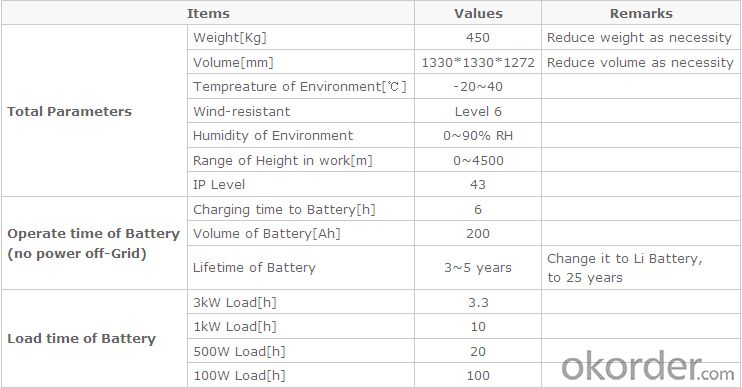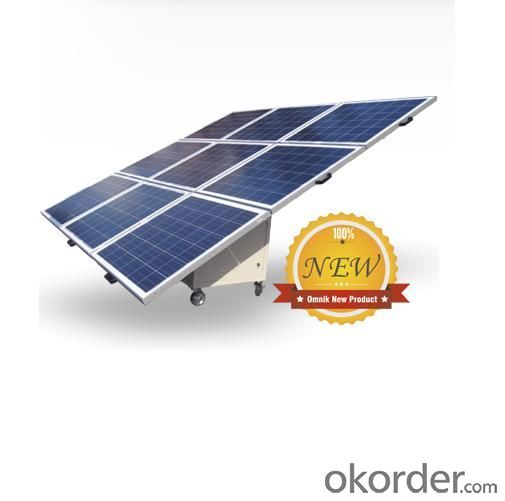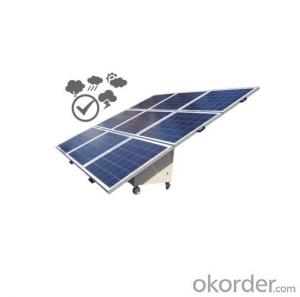Off grid solar car suitable fore developping area
- Loading Port:
- Shanghai
- Payment Terms:
- TT OR LC
- Min Order Qty:
- 1 pc
- Supply Capability:
- 3000 pc/month
OKorder Service Pledge
OKorder Financial Service
You Might Also Like
Off grid solar car suitable fore developping area
1.Futures
World's first, exclusively national-wide
Moveable, strong function in emergency
Huge Power output and world's top one
Self-Power generating, hard enduring
Large capacity, easy to use
Simple operation, low maintenance
Reliable quality, long lifetime
Remote monitoring, real-time data logging
2. datasheet

3. product certificate
EN 61000
VDE 0126-1-1
C10/11
G83/2
UTE C15-712-1
AS4777
CQC
CE10-21
EN50438
4. product outloot

FAQ
1. What price for each watt?
It depends on the efficiency of the solar cell, quantity, and delivery date and payment terms.
2. How long can we receive the product after purchase?
In the purchase of product within three working days, We will arrange the factory delivery as soon as possible. The pacific time of receiving is related to the state and position of customers. Commonly 7 to 10 working days can be served.
We can provide you not only the solar material but also the off grid solar system, we can also provide you service with on grid plant.
4. How do you pack your products?
We have rich experience on how to pack the solar cell to make sure the safety on shipment; we could use wooden box or pallet as buyer's preference.
5. Can you do OEM for us?
Yes, we can.
- Q:How does a solar inverter handle grid faults and disturbances?
- A solar inverter handles grid faults and disturbances by constantly monitoring the grid voltage and frequency. In case of a fault or disturbance, the inverter immediately disconnects from the grid to ensure safety and protect itself from damage. It then goes into a standby mode until the grid stabilizes. Once the grid is back to normal, the inverter reconnects and resumes normal operation, ensuring seamless and uninterrupted power supply from the solar panels.
- Q:How is a solar inverter different from a regular inverter?
- A solar inverter is specifically designed to convert the DC (direct current) electricity generated by solar panels into AC (alternating current) electricity suitable for use in homes and businesses. On the other hand, a regular inverter is mainly used to convert DC electricity from batteries or other sources into AC electricity. Therefore, while both inverters convert electricity from one form to another, a solar inverter is tailored for the unique requirements of solar power systems.
- Q:What is the role of fault ride-through capability in a solar inverter?
- The role of fault ride-through capability in a solar inverter is to ensure the stable and uninterrupted operation of the solar power system during grid disturbances or faults. It allows the inverter to remain connected to the grid and continue supplying power, even when there are short-term voltage dips or interruptions in the grid. This capability helps in maintaining grid stability and reliability while maximizing the energy generation from the solar panels.
- Q:What is the maximum input voltage that a solar inverter can handle?
- The maximum input voltage that a solar inverter can handle varies depending on the specific model and manufacturer. However, in general, most solar inverters can handle input voltages in the range of 600 to 1000 volts DC.
- Q:How is the output voltage and frequency of a solar inverter regulated?
- The output voltage and frequency of a solar inverter are regulated through a combination of control systems and power electronics. The control system continuously monitors the input from the solar panels and adjusts the inverter's operation accordingly. It analyzes the DC voltage generated by the panels and converts it to AC voltage at the desired frequency. This is achieved by controlling the switching of power electronic devices such as transistors or thyristors. These devices convert the DC power into high-frequency AC power, which is then transformed to the desired output voltage and frequency through a transformer or filter circuit. Overall, the regulation of the output voltage and frequency is achieved by the precise control of these power electronic components within the solar inverter.
- Q:How does a solar inverter handle electromagnetic interference (EMI)?
- A solar inverter typically handles electromagnetic interference (EMI) by incorporating various measures and technologies to minimize its impact. This includes using shielding materials and techniques to prevent EMI from affecting the internal electronics of the inverter. Additionally, filters and surge suppressors are employed to reduce EMI generated by the inverter from interfering with other electronic devices. Overall, the solar inverter aims to mitigate EMI issues to ensure optimal performance and minimize disruptions.
- Q:What is the role of a fault detection system in a solar inverter?
- The role of a fault detection system in a solar inverter is to monitor and identify any issues or malfunctions within the inverter system. It helps to prevent or minimize downtime by quickly detecting faults such as overvoltage, overcurrent, short circuits, or temperature abnormalities. By promptly identifying and alerting the system operator about these faults, the fault detection system allows for timely maintenance or repairs, ensuring optimal performance and safety of the solar inverter.
- Q:What is the role of a display interface in a solar inverter?
- The role of a display interface in a solar inverter is to provide real-time information and control options to the user. It allows the user to monitor and understand the performance of the solar inverter, such as the amount of energy being generated, the status of the system, and any potential issues. The display interface also enables the user to adjust and optimize the settings of the inverter, such as voltage and frequency, to ensure efficient operation. Overall, the display interface enhances the user experience by providing visibility and control over the solar inverter's functions.
- Q:Can a solar inverter be used in a solar-powered irrigation system?
- Yes, a solar inverter can be used in a solar-powered irrigation system. The solar inverter is responsible for converting the DC (direct current) power generated by the solar panels into AC (alternating current) power that is required for operating the irrigation system. This allows the solar panels to provide the necessary energy to power the irrigation system, making it an efficient and sustainable solution.
- Q:Can a solar inverter be used with a solar air conditioning system?
- Yes, a solar inverter can be used with a solar air conditioning system. The solar inverter helps convert the DC power generated by the solar panels into AC power that is suitable for powering the air conditioning system. This allows for the utilization of solar energy to cool or heat a building, making it an eco-friendly and energy-efficient solution.
1. Manufacturer Overview |
|
|---|---|
| Location | |
| Year Established | |
| Annual Output Value | |
| Main Markets | |
| Company Certifications | |
2. Manufacturer Certificates |
|
|---|---|
| a) Certification Name | |
| Range | |
| Reference | |
| Validity Period | |
3. Manufacturer Capability |
|
|---|---|
| a)Trade Capacity | |
| Nearest Port | |
| Export Percentage | |
| No.of Employees in Trade Department | |
| Language Spoken: | |
| b)Factory Information | |
| Factory Size: | |
| No. of Production Lines | |
| Contract Manufacturing | |
| Product Price Range | |
Send your message to us
Off grid solar car suitable fore developping area
- Loading Port:
- Shanghai
- Payment Terms:
- TT OR LC
- Min Order Qty:
- 1 pc
- Supply Capability:
- 3000 pc/month
OKorder Service Pledge
OKorder Financial Service
Similar products
New products
Hot products
Related keywords





























